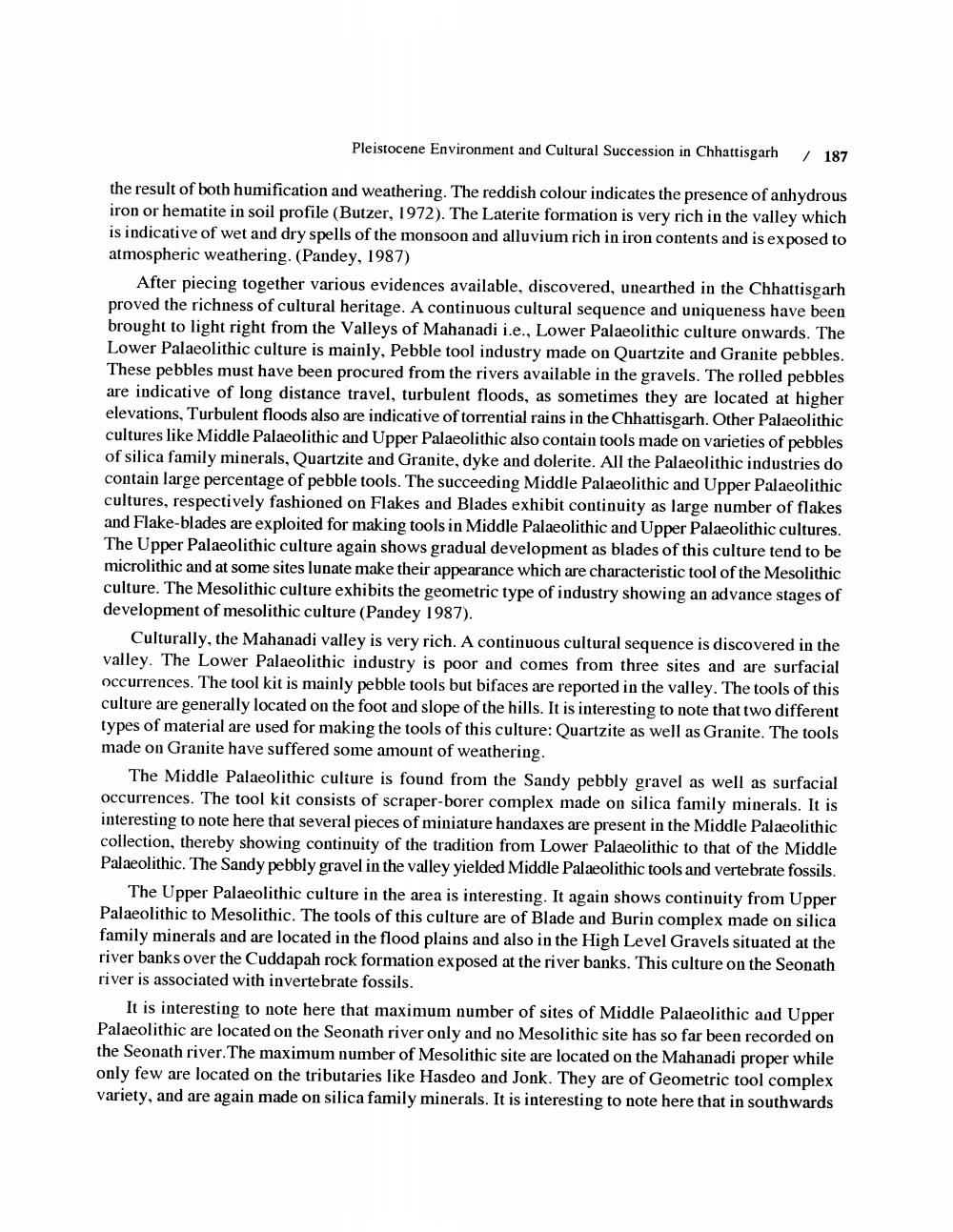________________
Pleistocene Environment and Cultural Succession in Chhattisgarh
/ 187
the result of both humification and weathering. The reddish colour indicates the presence of anhydrous iron or hematite in soil profile (Butzer, 1972). The Laterite formation is very rich in the valley which is indicative of wet and dry spells of the monsoon and alluvium rich in iron contents and is exposed to atmospheric weathering. (Pandey, 1987)
After piecing together various evidences available, discovered, unearthed in the Chhattisgarh proved the richness of cultural heritage. A continuous cultural sequence and uniqueness have been brought to light right from the Valleys of Mahanadi i.e., Lower Palaeolithic culture onwards. The Lower Palaeolithic culture is mainly, Pebble tool industry made on Quartzite and Granite pebbles. These pebbles must have been procured from the rivers available in the gravels. The rolled pebbles are indicative of long distance travel, turbulent floods, as sometimes they are located at higher elevations, Turbulent floods also are indicative of torrential rains in the Chhattisgarh. Other Palaeolithic cultures like Middle Palaeolithic and Upper Palaeolithic also contain tools made on varieties of pebbles of silica family minerals, Quartzite and Granite, dyke and dolerite. All the Palaeolithic industries do contain large percentage of pebble tools. The succeeding Middle Palaeolithic and Upper Palaeolithic cultures, respectively fashioned on Flakes and Blades exhibit continuity as large number of flakes and Flake-blades are exploited for making tools in Middle Palaeolithic and Upper Palaeolithic cultures. The Upper Palaeolithic culture again shows gradual development as blades of this culture tend to be microlithic and at some sites lunate make their appearance which are characteristic tool of the Mesolithic culture. The Mesolithic culture exhibits the geometric type of industry showing an advance stages of development of mesolithic culture (Pandey 1987).
Culturally, the Mahanadi valley is very rich. A continuous cultural sequence is discovered in the valley. The Lower Palaeolithic industry is poor and comes from three sites and are surfacial occurrences. The tool kit is mainly pebble tools but bifaces are reported in the valley. The tools of this culture are generally located on the foot and slope of the hills. It is interesting to note that two different types of material are used for making the tools of this culture: Quartzite as well as Granite. The tools made on Granite have suffered some amount of weathering.
The Middle Palaeolithic culture is found from the Sandy pebbly gravel as well as surfacial occurrences. The tool kit consists of scraper-borer complex made on silica family minerals. It is interesting to note here that several pieces of miniature handaxes are present in the Middle Palaeolithic collection, thereby showing continuity of the tradition from Lower Palaeolithic to that of the Middle Palaeolithic. The Sandy pebbly gravel in the valley yielded Middle Palaeolithic tools and vertebrate fossils.
The Upper Palaeolithic culture in the area is interesting. It again shows continuity from Upper Palaeolithic to Mesolithic. The tools of this culture are of Blade and Burin complex made on silica family minerals and are located in the flood plains and also in the High Level Gravels situated at the river banks over the Cuddapah rock formation exposed at the river banks. This culture on the Seonath river is associated with invertebrate fossils.
It is interesting to note here that maximum number of sites of Middle Palaeolithic and Upper Palaeolithic are located on the Seonath river only and no Mesolithic site has so far been recorded on the Seonath river. The maximum number of Mesolithic site are located on the Mahanadi proper while only few are located on the tributaries like Hasdeo and Jonk. They are of Geometric tool complex variety, and are again made on silica family minerals. It is interesting to note here that in southwards




